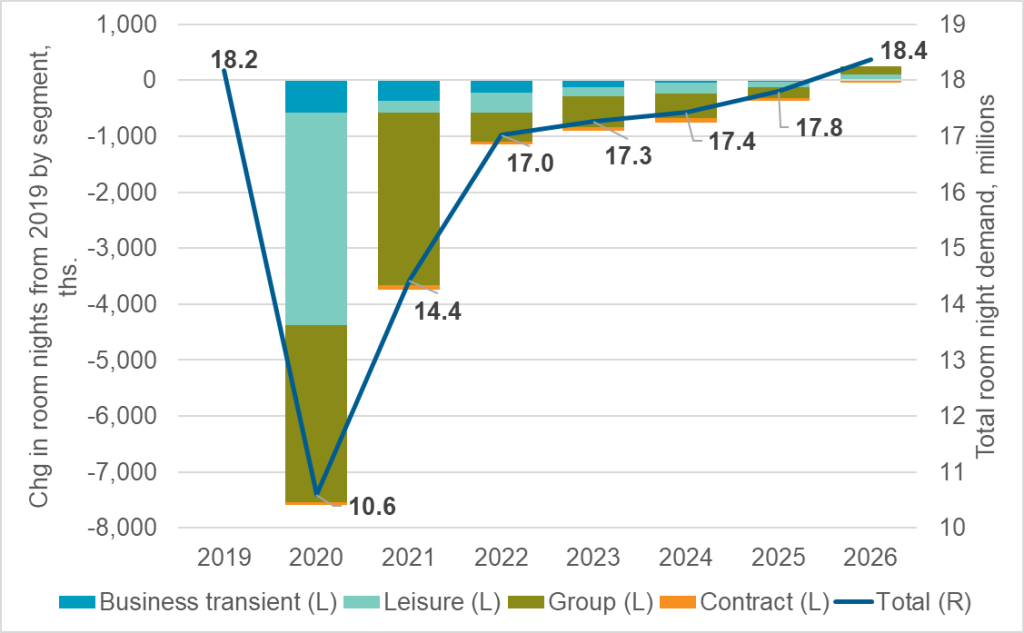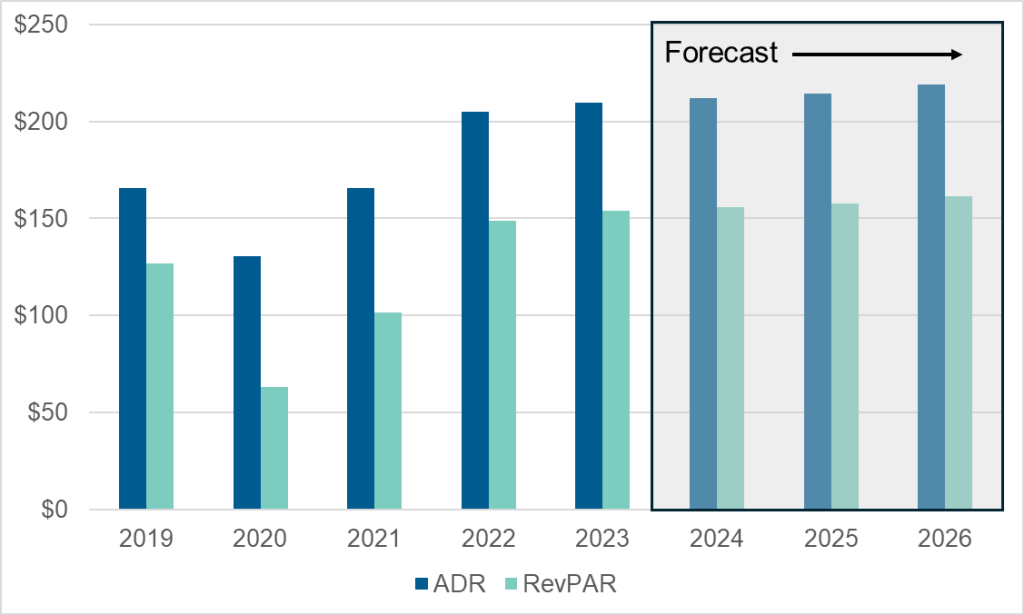March delivered a much-welcome boost to hotel performance after a sluggish start to 2024. Data from Smith Travel Research (STR) indicates that San Diego County properties sold more than 1.5 million room nights in March 2024, a 2.3% increase over March 2023 and enough to draw in more than $316 million in hotel revenues.
However, this uptick was not enough to undo the constant stormy, wet, and cool weather that characterized the start of this year and dented hotel demand and average daily rates (ADR) in January and February. Sales fell short of the January 2024 forecast (which included historical data through November) by some 90,000 room nights in the first two months. This prompted a modestly downward revision of our 2024 room demand projections by nearly 200,000 room nights, from 17.6 million room nights in the January forecast to 17.4 million in the April projection.

The 2024 room night demand downgrades led us to reassess forecasts for 2025 and 2026. Considering historical trends and the current business cycle phase, projections for 2025 and 2026 were also lowered to better reflect more normalized growth rates amid rising competitive pressures nationally and increased price sensitivity among travelers. As a result, based on the most recent forecasts, we pushed back the projected full recovery of rooms from 2025 in the January forecast to 2026 in the April forecast.

However, San Diego remains one of the top-ranked U.S. destination. In 2023, the region scored the third-highest occupancy among STR’s top 25 markets at 73.4% and 17.3 million room nights sold. The 2024 forecast builds on that strength, albeit modestly, with occupancy perched at 73.5% this year followed by incremental increases to 73.6% in 2025 and 73.8% in 2026.

It’s also important to note that San Diego endured miserable weather conditions in 2023 as El Nino blanketed the region with a thick marine layer through May until the summer season provided relief. Given that hotel performance has already bounced back in March, there is still room for cautious optimism that 2024 will not only be a better year than 2023 but that it could very well surpass our admittedly conservative forecasts. However, until we see continual improvement in performance, we will maintain a restrained approach to projecting this year.
As mentioned earlier, room night demand has quite a way to go before it matches the 2019 high-water mark of 18.2 million. While 17.4 million room nights reflects a slight improvement over last year’s 17.3 million, demand remains 800,000 room nights below pre-pandemic levels.
As the pandemic bore down in 2020, all segments suffered severe losses, but none worse than the leisure and group segments, which sold 3.8 million and 3.1 million fewer room nights, respectively, in 2020 versus 2019. However, in 2021, leisure came roaring back, closing the gap with 2019 by a mere 2%. Meanwhile, Group room night sales were anchored at 59% below 2019 levels as meetings and conventions remained closed for business. In fact, of the 800,000 room night deficit between the 2024 forecast and 2019 actuals, more than half (437k) stem from Group.
All told, it won’t be until 2026 until most market segments find their way back to levels above those seen in 2019. However, it’s worth noting that Group room night sales among upscale+ properties have already recovered to 2019 levels, meaning the differential in the Total Group segment lies solely within the mid-scale and economy chains.


A little less uncertain are the forecasts for ADR and revenue per available room (RevPAR). Travelers have become highly price-conscious, with multiple travel sentiment surveys showing accommodations and airfare costs as top barriers to travel. As a result, hotels have little wiggle room to raise rates until consumers’ pricing power fully recovers after several years of inflation and the sticker shock of higher rates subsides. As such, the ADR and RevPAR forecasts are essentially flat over the next several years.

In conclusion, hotel revenues are expected to experience very modest, nearly flat growth over the next several years. This should give pause to business owners and policymakers alike as they project P&L and tax collections in the coming years. While odds favor better-then-projected performance in the medium term, a wait-and-see approach remains the most responsible way to move forward with so many lingering uncertainties.
Leave a Reply